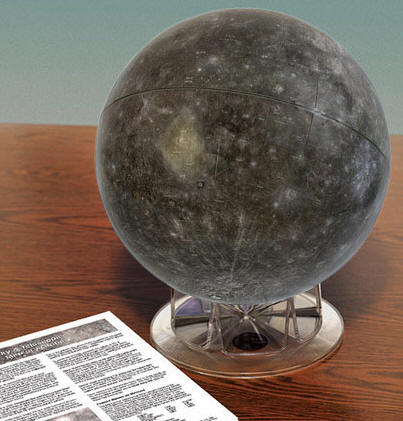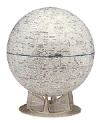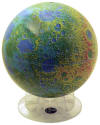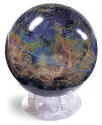|
||||
|
||||
|
World Globes> Desktop Globes > Astronomy Globes and Planetariums > Mercury
- Mercury Globe Item # STMERCGLB
-

Currently Unavailable
For centuries, our solar system's innermost planet was shrouded in mystery. Now, for the first time ever, you can use a globe to explore Mercury's entire surface! This new 12-inch globe was made possible by NASA's Messenger spacecraft, which recently finished imaging the entire planet.
The base map comes from about 18,000 Messenger images, and special image processing has preserved the natural light and dark shading of the surface. The names of more than 350 craters and other features are labeled, including craters named after famous artists, musicians, painters, and authors.Diameter: 12" (30 cm)
Height: 15" (38 cm)
Weight: 3.7 lbs. (1.7 kg)Until the 1970s, Mercury was almost completely shrouded in mystery because of its small size and proximity to the Sun. Even the largest telescopes showed only the subtlest of hints of surface features. That changed in mid 70s, when NASA’s Mariner 10 spacecraft made three flybys of the innermost planet, revealing a battered, heavily cratered landscape that was reminiscent of our Moon. Still, the three flybys managed to image only about 45% of the planet’s surface.
NASA’s Messenger spacecraft (short for Mercury Surface, Space Environment, Geochemistry, and Ranging) was launched in 2004 and flew by Mercury three times before entering a highly elongated orbit in March 2011. Over the next two years, Messenger took thousands of pictures of Mercury’s surface from different distances and under different illumination conditions. By mid-2013, the Messenger science team had enough imaging data to produce a global map of Mercury’s surface.
Music buffs will enjoy the names of Mercurian craters, since they honor some famous composers including Bach, Beethoven, and Monk (Thelonious). Other features are named after great writers, artists, and various contributors to the humanities.
“Huge volcanic plains cover areas such as the Caloris Basin” says mapmaker Denevi. “And even though much of Mercury is cratered like the lunar highlands, it appears this terrain is substantially younger than the highlands, has a different composition, and may have formed in a completely different manner. Our understanding of the planet is evolving every day.”
| Moon 12" Globe | Topographic 12" Moon | Venus 12" Globe |
 |
 |
 |
Call us toll-free 877-822-9889 or 812-333-2772 for orders/questions Mon.-Sat. 10:00 am-5:30 pm Eastern Standard Time
Mercury Desktop Globe by ST, Item # MERCGLB
Sale Price: $129.99, NASA Cartography, Sculptured Base, Tabletop

